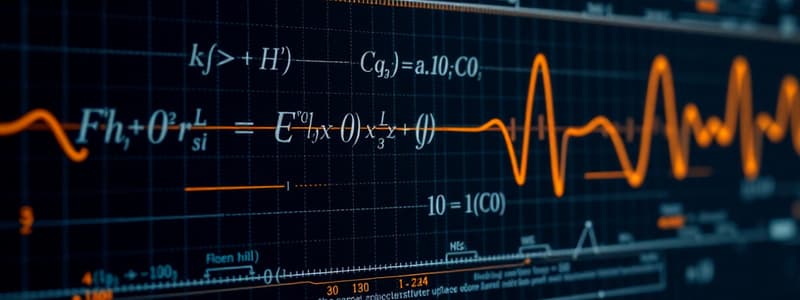Podcast
Questions and Answers
What is the primary function of Laplace Transform in signal analysis?
What is the primary function of Laplace Transform in signal analysis?
- To differentiate signals
- To stabilize signals
- To amplify signals
- To convert time domain signals to frequency domain (correct)
The Region of Convergence (ROC) for Laplace Transforms does not affect the stability of the system.
The Region of Convergence (ROC) for Laplace Transforms does not affect the stability of the system.
False (B)
What is the mathematical representation of the Laplace Transform for a function x(t)?
What is the mathematical representation of the Laplace Transform for a function x(t)?
X(s) = ∫[0, ∞] x(t)e^(-st) dt
The _______ transform is used to analyze differential equations in the context of electrical circuits.
The _______ transform is used to analyze differential equations in the context of electrical circuits.
Match the following concepts related to Laplace Transforms with their descriptions:
Match the following concepts related to Laplace Transforms with their descriptions:
What does ROC stand for in the context of signal processing?
What does ROC stand for in the context of signal processing?
The stability of a system can be determined by analyzing the poles in the s-plane.
The stability of a system can be determined by analyzing the poles in the s-plane.
Explain the significance of the inverse transform in signal processing.
Explain the significance of the inverse transform in signal processing.
In ROC analysis, for a system to be stable, all poles must lie in the ______ half of the s-plane.
In ROC analysis, for a system to be stable, all poles must lie in the ______ half of the s-plane.
Match the following concepts with their proper descriptions:
Match the following concepts with their proper descriptions:
Which of the following statements regarding Complex Frequency Domain is true?
Which of the following statements regarding Complex Frequency Domain is true?
The ROC can affect the final output signal obtained after performing the inverse transform.
The ROC can affect the final output signal obtained after performing the inverse transform.
What role does ROC analysis play in system design?
What role does ROC analysis play in system design?
What is the primary method to obtain convolution in the time domain?
What is the primary method to obtain convolution in the time domain?
The Region of Convergence (ROC) cannot contain poles of a system function.
The Region of Convergence (ROC) cannot contain poles of a system function.
What does the acronym LTI stand for in the context of systems?
What does the acronym LTI stand for in the context of systems?
The stability criteria for a system requires that the ROC is ______ the right half of the s-plane.
The stability criteria for a system requires that the ROC is ______ the right half of the s-plane.
Match the following types of signals with their respective forms:
Match the following types of signals with their respective forms:
In terms of inverse transformations, which of the following functions leads to a ramp signal in the time domain?
In terms of inverse transformations, which of the following functions leads to a ramp signal in the time domain?
A system with poles in the left half of the s-plane is always stable.
A system with poles in the left half of the s-plane is always stable.
Identify the essential criteria for determining the stability of a linear system.
Identify the essential criteria for determining the stability of a linear system.
The Laplace transform of a sine wave is ______.
The Laplace transform of a sine wave is ______.
Which function represents the frequency response for a complex exponential?
Which function represents the frequency response for a complex exponential?
Flashcards
Signal Transformation
Signal Transformation
Converting a signal from the time domain (t) to the frequency domain (s). Example using Laplace Transform.
Laplace Transform
Laplace Transform
A mathematical tool that transforms functions of time (like signals) into functions of complex frequency (s).
s-plane
s-plane
A complex plane that represents frequency in the context of the Laplace transform.
ROC (Region of Convergence)
ROC (Region of Convergence)
Signup and view all the flashcards
Convolution
Convolution
Signup and view all the flashcards
Linear Time-Invariant System (LTI)
Linear Time-Invariant System (LTI)
Signup and view all the flashcards
X(s)
X(s)
Signup and view all the flashcards
Time function
Time function
Signup and view all the flashcards
Bilateral Laplace Transform
Bilateral Laplace Transform
Signup and view all the flashcards
Unilateral Laplace Transform
Unilateral Laplace Transform
Signup and view all the flashcards
Region of Convergence (ROC)
Region of Convergence (ROC)
Signup and view all the flashcards
Laplace Transform of a Constant
Laplace Transform of a Constant
Signup and view all the flashcards
Laplace Transform - Time Domain to Frequency Domain
Laplace Transform - Time Domain to Frequency Domain
Signup and view all the flashcards
LTI System
LTI System
Signup and view all the flashcards
Impulse Response
Impulse Response
Signup and view all the flashcards
Step Response
Step Response
Signup and view all the flashcards
Ramp Response
Ramp Response
Signup and view all the flashcards
Exponential Response
Exponential Response
Signup and view all the flashcards
Study Notes
Laplace Transforms
- Laplace Transforms (LT) are a powerful tool for converting differential equations into algebraic equations.
- LT converts time-domain signals into the frequency domain.
- LT converts differential equations in the time domain to algebraic equations in the frequency domain.
Definition of Laplace Transform
- The Laplace transform of a time function x(t) is defined as: L[x(t)] = X(s) = ∫0∞ x(t)e-st dt
- Where 's' is a complex variable and s = σ + jw
- σ is the real part of s
- jw is the imaginary part of s
- Two sided / bilateral transform takes into account the entire range of input signal (–∞ to ∞).
- One sided / unilateral transform uses the range of the input signal from 0 to ∞.
Region of Convergence (ROC)
- The ROC is the set of 's' values for which the Laplace transform integral converges.
- A signal has a Laplace transform only if the ROC exists.
- Bilateral Laplace transforms of a signal x(t) exists if ∫-∞∞|x(t)|e-σt dt is finite.
- ROC is a region in the s-plane.
Existence of Laplace Transform
- The signal x(t) must be continuous over a given closed interval.
- x(t)e-st must be absolutely integrable.
Advantages of Laplace Transform
- Signals that do not converge in the Fourier transform (FT) may converge in the Laplace transform (LT).
Convolution Theorem
- Convolution in the time domain is equivalent to multiplication in the frequency domain.
Limitations of Laplace Transform
- Frequency response cannot be directly estimated.
- Only pole-zero plot can be presented.
- 's = jw' is used only in sinusoidal steady-state analysis.
Impulse Signal δ(t)
- Impulse (delta) function δ(t) is defined as: δ(t) = 1, for t = 0 δ(t) = 0, for t ≠ 0
- The L[δ(t)] = 1
Step Signal u(t)
- The unit step function u(t) is defined as: u(t) = 1, for t ≥ 0 u(t) = 0, for t < 0
- L[u(t)] = 1/s for Re(s) >0
- The ROC is the entire right-half of the s-plane.
Ramp Signal t u(t)
- L[t u(t)] = 1/s2, Re(s) > 0
- ROC is the entire right-half of the s-plane.
Exponential Signal eat u(t)
- L[eatu(t)] = 1/(s - a), Re(s) > a
- The ROC is the region with Re(s) > a.
Complex Exponential Signal ejwt u(t)
- L[ejwt u(t)] = 1/(s - jw), Re(s) > 0
- The ROC is the entire right-half of the s-plane
Sine and Cosine Signals
-
L[ sin(ωt) u(t)] = ω/(s2 + ω2)
-
L[ cos(ωt) u(t)] = s / (s2 + ω2)
Additional Notes
-
Multiple signals with different exponential terms
- These can be combined to form a single result using the linearity of Laplace Transform.
-
The ROC of the combined signal should be found using the ROC rules.
Studying That Suits You
Use AI to generate personalized quizzes and flashcards to suit your learning preferences.




